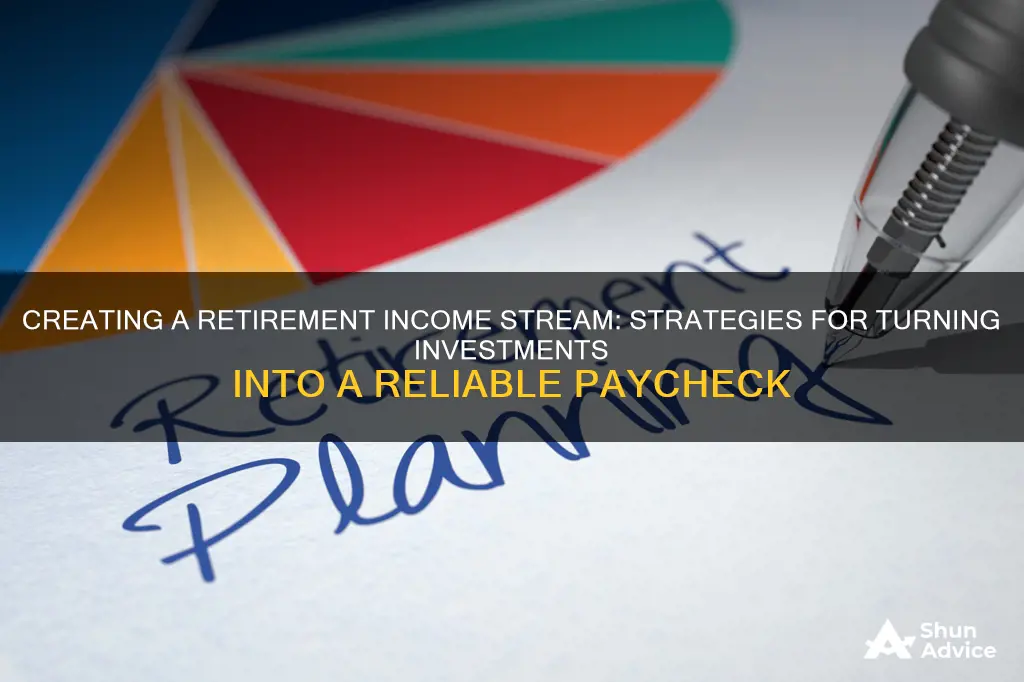
Building a retirement fund is a long-term process that requires commitment and discipline. The first step is to start saving, even if it's just a few dollars a week. Once you've made saving a habit, the next step is to increase your income and reduce your debts. This will enable you to put more money into your retirement fund.
It's not enough to just save money, though. You also need to invest it wisely. Retirement accounts often have tax advantages, and by taking advantage of your company's 401(k), you may also receive matching contributions.
There are several strategies you can use to turn your investments into a retirement paycheck. One common approach is to establish a bucket strategy, which involves dividing your investments into different buckets based on when you need to use the money. Another strategy is to focus on generating income through interest and dividends from bond and stock investments. A third option is to use a total return approach, where you construct a diversified portfolio of stock and bond index funds and withdraw money as needed.
The key to a successful retirement plan is to start early, be consistent, and make sure your investments are aligned with your goals and risk tolerance.
| Characteristics | Values |
|---|---|
| Number of Buckets | 3 |
| Bucket 1 | The Cash Bucket |
| Bucket 1 Target | 1-3 years of spending requirements not covered with other income |
| Bucket 2 | The Income Bucket |
| Bucket 2 Target | 7-8 years of spending |
| Bucket 3 | Long-Term Growth |
| Bucket 3 Target | Money in this bucket shouldn't be touched for ~10 years |
| Tax-efficient withdrawal strategy | Withdraw from taxable accounts first, then tax-deferred, then tax-free |
| Guaranteed Income Sources | Social Security, pension, fixed annuity |
| Withdrawal rate | 4% or less |
| Investment Strategy | Interest and dividend investing, total return investing, managed payout funds |
What You'll Learn

Calculate your regular expenses
When planning for retirement, it is important to calculate your regular expenses to ensure that you have a sustainable income stream. Here are some steps to help you estimate your monthly expenses during retirement:
- Identify your essential expenses: These are the must-have costs that you will need to cover during retirement. This includes household expenses, transportation, living expenses, family care, and medical/health costs.
- Anticipate discretionary expenses: Discretionary expenses are optional costs that you may choose to spend on entertainment, dining out, hobbies, subscriptions, travel, charitable donations, etc. While these expenses can be reduced or eliminated if needed, it is important to consider them in your budget.
- Plan for one-time expenses: There may be unexpected costs during retirement, such as a child's wedding, emergency home repairs, or medical expenses. It is important to factor these potential expenses into your budget to avoid financial strain.
- Understand tax implications: Don't forget to include federal, state, and local income taxes, as well as property taxes if you own a home. These taxes will impact your overall expenses and should be considered when calculating your regular expenses.
- Track your expenses: To get a clear picture of your spending, it is helpful to track your expenses for a few months. This will allow you to compare your estimates with your actual expenses and make any necessary adjustments to your budget.
- Consider the impact of inflation: Inflation can increase your cost of living over time. When calculating your regular expenses, try to anticipate how inflation may affect your expenses in the future.
- Seek professional advice: Consult a financial advisor or planner to help you estimate your expenses and create a comprehensive retirement budget. They can provide valuable insights and guidance tailored to your specific situation.
By following these steps and seeking professional advice, you can more accurately calculate your regular expenses and develop a retirement plan that meets your needs.
Analyzing Investment Opportunities: Strategies for Success
You may want to see also

Identify your income sources
Identifying your income sources is the first step towards building a retirement paycheck from your investments. Here are some common sources of retirement income:
- Social Security Benefits: Social Security will likely be a significant source of retirement income for most retirees. The Social Security Administration (SSA) offers tools and resources to help you understand your benefits and plan for retirement. You can choose to receive reduced benefits as early as age 62 or wait until you are eligible for full benefits, typically around age 65-67, or even longer to qualify for higher payments. It is recommended to consult Social Security calculators to determine the optimal time to start receiving benefits.
- Pensions: If you have a defined benefit pension, you should know the amount of pension income you'll receive, usually based on your years of service, earnings, and age when you stopped working. Government pensions and military retired pay often differ from corporate pensions and may offer earlier retirement and automatic adjustments for inflation.
- Employer-Sponsored Retirement Plans: These include 401(k)s, 403(b)s, 457(b)s, SIMPLE IRAs, and SEP IRAs. These plans allow you to contribute a portion of your income towards retirement and offer tax advantages.
- Other Retirement Savings: This includes brokerage accounts, savings accounts, and certificates of deposit (CDs).
- Annuities: Annuities are insurance products that provide a guaranteed income stream for life, often purchased with a lump sum. While they offer a stable income, they may not keep up with inflation, and you give up control of your money.
- Interest and Dividend Investing: You can generate income from bond investments and dividend-paying stocks. However, low bond yields and variable dividend payments may not provide sufficient income for retirees.
- Total Return Investing: This strategy involves constructing a diversified portfolio of stock and bond index funds to maximize total returns. Withdrawals are made from the portfolio as needed, and rebalancing is done to maintain the desired asset allocation.
- Managed Payout Funds: These mutual funds are designed for retirees and manage investments to provide income through interest and dividend payments. However, they may not be tax-efficient and may not provide sufficient equity exposure.
- Home Equity: Your home can be a source of retirement income through a sale or a reverse mortgage, which allows you to convert home equity into a loan or income stream.
It is important to categorize your income sources into groups such as lifetime income (Social Security, pensions), dividend income (stocks, equity funds), and interest income (bonds, fixed-income instruments) to understand their predictability and how they can cover essential and discretionary expenses. Diversifying your income across these categories can help safeguard your retirement and provide income that lasts a lifetime.
The Debt-Investment Dilemma: Navigating the Path to Financial Freedom
You may want to see also

Determine an appropriate withdrawal strategy
There are several withdrawal strategies that you can use to build a retirement paycheck from your investments. Here are some of the most common ones:
- The 4% Rule: This strategy involves withdrawing 4% of your retirement savings in the first year of retirement and then adjusting the amount each year for inflation. For example, if you have $1 million saved, you would withdraw $40,000 in the first year. In the second year, you would increase the withdrawal amount by the inflation rate. This approach is simple and provides a predictable income stream. However, it does not consider market conditions and can lead to running out of money in down markets or spending less than you can afford in up markets.
- Fixed-Dollar Withdrawals: With this strategy, you decide on a fixed dollar amount to withdraw each year and then reassess after a certain period (e.g., every five years). This approach provides predictability and simplicity but does not account for inflation. If the market performs poorly, you may need to sell more assets to meet your withdrawal needs.
- Fixed-Percentage Withdrawals: This strategy involves withdrawing a fixed percentage of your portfolio each year, regardless of market performance. For example, if you have $1 million, you would withdraw $40,000 (4%) in the first year. The advantage is that it's simple to understand and implement, and it adjusts your withdrawals based on market fluctuations. However, your income will vary from year to year, making financial planning more challenging.
- Systematic Withdrawal Plan: This approach only withdraws the income generated by your investments (dividends or interest) while leaving the principal untouched. It aims to prevent you from running out of money and allows your investments to potentially grow over time. However, the amount of income you receive can vary significantly depending on market performance, and there is a risk of being outpaced by inflation.
- The Bucket Strategy: This strategy divides your retirement savings into three buckets: short-term, intermediate-term, and long-term. The short-term bucket holds cash and other liquid assets to cover living expenses for the next 3-5 years. The intermediate bucket contains fixed-income securities for expenses in the next 5-10 years. The long-term bucket holds equities and long-term bonds for growth throughout retirement. This approach allows your savings to continue growing, but it requires more time and effort to manage.
When choosing a withdrawal strategy, consider your risk tolerance, desired income stability, and the potential impact of inflation. It's also important to regularly review and adjust your strategy as your circumstances change.
Ford: A Smart Investment Move
You may want to see also

Consider the tax and investment implications of withdrawing from each source
When it comes to withdrawing from your retirement investments, there are a few key things to keep in mind in terms of tax and investment implications.
Firstly, it's important to understand the tax treatment of different types of retirement accounts. Traditional retirement accounts, such as 401(k)s, 403(b)s, and IRAs, are typically tax-deferred. This means that contributions to these accounts are made on a pre-tax basis, reducing your taxable income for the year. However, when you withdraw from these accounts in retirement, you will generally pay income tax on the distributions. On the other hand, Roth accounts, such as Roth 401(k)s and Roth IRAs, are funded with after-tax contributions. This means that withdrawals from these accounts in retirement are generally tax-free, assuming certain conditions are met.
When deciding which accounts to withdraw from and when, it's important to consider the potential tax implications. Withdrawing from tax-deferred accounts will generally trigger income tax, while withdrawing from Roth accounts will not. One strategy, known as the "proportional withdrawal" strategy, involves withdrawing from each account based on its percentage of your overall savings. This can help spread out taxable income more evenly over your retirement, potentially reducing taxes on Social Security benefits and Medicare premiums. Another strategy is to first withdraw from taxable accounts, then tax-deferred accounts, and finally Roth accounts. This allows tax-deferred assets to grow over a longer period.
It's also important to keep in mind the impact of withdrawals on your overall investment portfolio. Withdrawing too much from any one account can disrupt your asset allocation and potentially increase investment risk. Additionally, early withdrawals from retirement accounts, such as 401(k)s, before the age of 59 1/2 typically incur a 10% penalty on top of regular income tax. There are some exceptions to this rule, such as certain hardship distributions or qualified domestic relations orders.
Finally, don't forget about Required Minimum Distributions (RMDs). Once you reach a certain age, typically 72 or 73, you are required to start taking minimum distributions from tax-deferred accounts like traditional 401(k)s and IRAs. Failing to take the required minimum distribution can result in a significant penalty from the IRS.
Investments of the 1950s: Where Did People Put Their Money?
You may want to see also

Review your portfolio to ensure it has the potential to last 30+ years
Reviewing your portfolio is a critical step in ensuring its longevity and ability to last 30+ years. Here are some detailed instructions to help you through the process:
Understand the concept of time-weighted returns (TWR) and money-weighted returns (MWR):
TWR focuses on the portfolio's investment performance by removing the impact of external cash flows. It is useful for evaluating the effectiveness of your investment strategy and comparing it with other portfolios or funds. On the other hand, MWR accounts for the timing and size of contributions and withdrawals, providing a personalised view of investment performance.
Calculate your portfolio's returns using different methods:
You can use the ROI formula ((Net gain on investment + dividends - fees) / Initial cost of investment) for a straightforward calculation. For more complex scenarios involving deposits and withdrawals, consider using the modified Dietz method or the internal rate of return (IRR) to adjust for cash flows accurately.
Annualise your returns for better comparability:
Annualising returns is essential when comparing your portfolio's performance with others or different asset classes. It provides a standardised yearly figure that accounts for compounding effects, making it easier to assess relative performance.
Assess your portfolio's performance and make adjustments:
Compare your portfolio's returns with relevant benchmarks to identify underperforming or overperforming areas. Evaluate whether your investments are maintaining the desired level of risk and if your asset allocation strategy needs adjustments. This process will help you identify areas where you may need to rebalance your portfolio to align with your risk tolerance and investment goals.
Monitor your portfolio regularly and rebalance as needed:
Continuously monitor your investments and measure their performance against your benchmarks. Review your portfolio at least annually to assess if your financial goals, risk tolerance, or investment mix have changed. If adjustments are required, rebalance your portfolio by buying or selling investments to restore your target allocation.
Seek professional guidance:
Consulting a trusted financial advisor or broker can provide valuable insights and guidance throughout your investment journey. They can help you navigate tax implications, risk management, and provide personalised advice based on your specific circumstances.
By following these steps and regularly reviewing your portfolio, you can ensure that it remains aligned with your long-term financial objectives and has the potential to last 30+ years.
Ratios Reveal: Investing Insights
You may want to see also
Frequently asked questions
The Bucket Strategy is a common approach to setting up your investments for the withdrawal phase. It involves establishing three "buckets" with different risk levels and functions. Bucket One is the "Cash Bucket", which should be fully liquid, risk-free, and readily available. It typically contains one to three years' worth of spending requirements. Bucket Two is the "Income Bucket", which aims to generate income with controlled risk. It is used to periodically refill Bucket One. Bucket Three is for long-term growth and typically has the highest risk and potential for returns.
You can create a retirement "paycheck" by implementing strategies such as annuitizing a portion of your portfolio, investing in interest and dividends, adopting a total return investing approach, or using managed payout funds. It's important to consider tax efficiency, guaranteed income sources, and required minimum distributions when developing your strategy.
Financial planners often recommend the 4% rule, which suggests withdrawing 4% of your portfolio in the first year and adjusting for inflation in subsequent years. However, some planners suggest a more conservative approach, such as the "Spend Safely in Retirement" method, which recommends withdrawal rates based on age and the IRS' required minimum distribution rules.
It's generally recommended to cover essential expenses with predictable sources of income, such as Social Security, pension payments, annuities, or interest income. For discretionary expenses, consider tapping into growth assets or less predictable income sources from your portfolio, such as stock dividends or mutual fund distributions. When deciding which accounts to tap first, consider the tax implications and the impact on your overall asset allocation.







